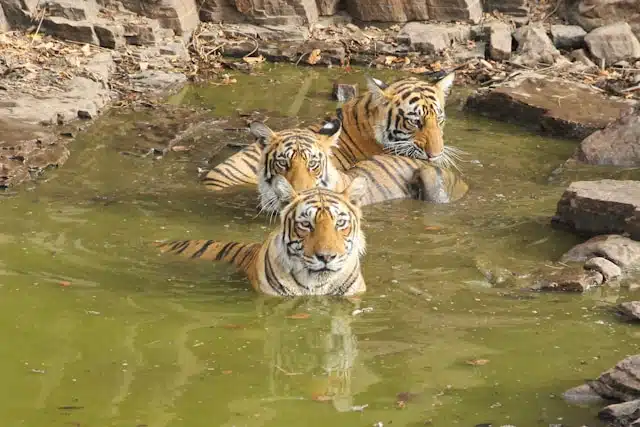Located in the southeastern part of Rajasthan, Ranthambore National Park is one of India’s most famous wildlife sanctuaries and a premier destination for spotting the majestic Bengal tiger. Spread across 1,334 square kilometers, Ranthambore offers a unique blend of history, nature, and wildlife. Once the hunting grounds of the Maharajas of Jaipur, the park is now a protected area that allows visitors to experience the wild beauty of Rajasthan in its natural habitat.
Ranthambore: A Thrilling Safari Adventure
Whether you’re a wildlife enthusiast, a nature lover, or simply looking to escape into the serene wilderness, Ranthambore is a must-visit destination that promises adventure, excitement, and unforgettable experiences.


Bengal Tigers and Wildlife Safari
The biggest draw to Ranthambore is, undoubtedly, the chance to see the Bengal tiger in its natural environment. The park is home to a healthy population of these magnificent creatures, making it one of the best places in India for tiger sightings. Embark on a wildlife safari through the park’s diverse terrain of dry forests, grasslands, and lakes, and keep an eye out for tigers basking in the sun or stalking their prey.
In addition to tigers, Ranthambore is home to a variety of wildlife species, including leopards, sloth bears, crocodiles, jackals, and a range of birdlife. The park offers both jeep and canter safaris, which take you deep into the jungle for a closer look at the park’s wildlife. While tiger sightings are never guaranteed, the park’s rugged beauty and rich biodiversity make the safari experience worthwhile.


Ranthambore Fort: A Glimpse into History
Perched on a hilltop inside the national park, the Ranthambore Fort is a UNESCO World Heritage site that dates back to the 10th century. The fort is steeped in history, with its ancient walls witnessing centuries of battles, rulers, and royal intrigue. It was once a key stronghold for the rulers of Rajasthan and played a significant role in the region’s history.
Climbing up to the fort offers a fantastic opportunity to explore ancient ruins, temples, and palaces while enjoying panoramic views of the surrounding forest and lakes. Among the attractions within the fort are the Ganesh Temple, dedicated to Lord Ganesha, and several old royal pavilions that provide a glimpse into the grandeur of the past. The fort is a peaceful spot, often visited by pilgrims and history buffs alike.
Lakes and Wildlife: Padam Talao and Malik Talao
Ranthambore is home to several scenic lakes that are not only a water source for the park’s wildlife but also offer excellent spots for birdwatching and wildlife photography. Among these, Padam Talao, the largest lake in Ranthambore, is particularly famous for its water lilies and for being a favored spot for tigers to rest during the heat of the day.
Malik Talao, another lake within the park, is known for its large population of mugger crocodiles that bask along its shores. The lakes are surrounded by dense forests and rocky outcrops, making them ideal for spotting various animals such as sambar deer, chital, and birds like kingfishers, herons, and eagles.
Best Time to Visit Ranthambore
The best time to visit Ranthambore is between October and April, when the weather is pleasant and the chances of spotting tigers are higher. During the summer months (April to June), temperatures can soar, but wildlife sightings, especially tigers near water bodies, are more frequent. Monsoon season (July to September) sees the park close to visitors due to heavy rainfall.
Travel Tips
- Safari Booking: It is recommended to book your safaris well in advance, especially during peak season. Choose between jeep safaris (6 people) for a more intimate experience or canter safaris (20 people) for a group experience.
- Camera Gear: If you’re into wildlife photography, don’t forget to bring a good zoom lens to capture tigers and other animals from a distance. Also, pack binoculars for birdwatching.
- Fort Visit: Combine your wildlife safari with a visit to Ranthambore Fort for a mix of history and nature. Comfortable walking shoes are a must, as the fort involves a bit of hiking.
- Clothing: Since Rajasthan can be quite hot, especially in summer, wear light, breathable clothing for your safari. However, mornings and evenings can be cooler, so it’s a good idea to bring a jacket or shawl.
Ranthambore offers the perfect combination of wildlife adventure and historical exploration. Whether you’re spotting Bengal tigers on a safari or exploring the ancient Ranthambore Fort, this national park provides an unforgettable experience that connects visitors to the beauty and rich history of Rajasthan’s wilderness










